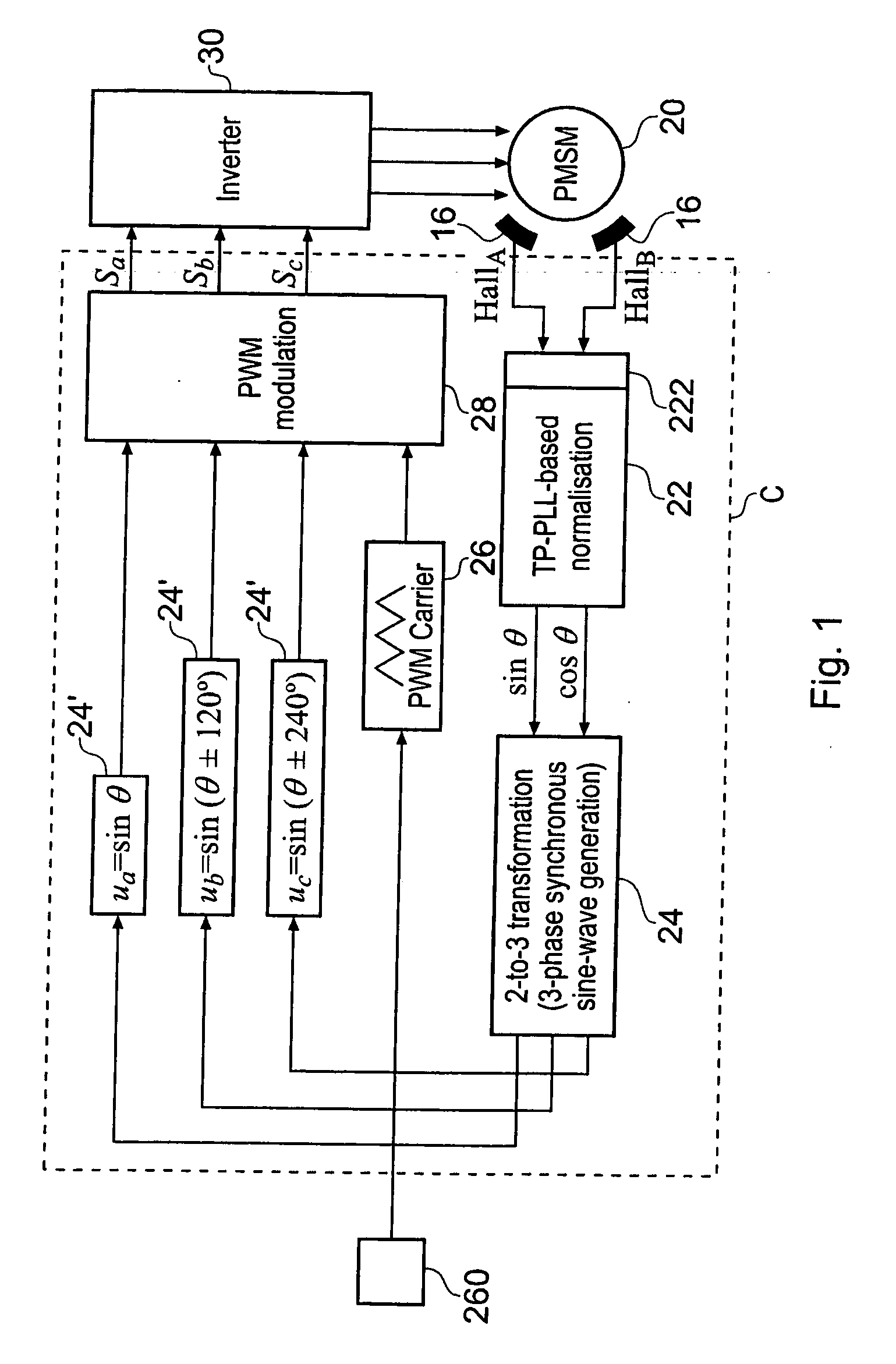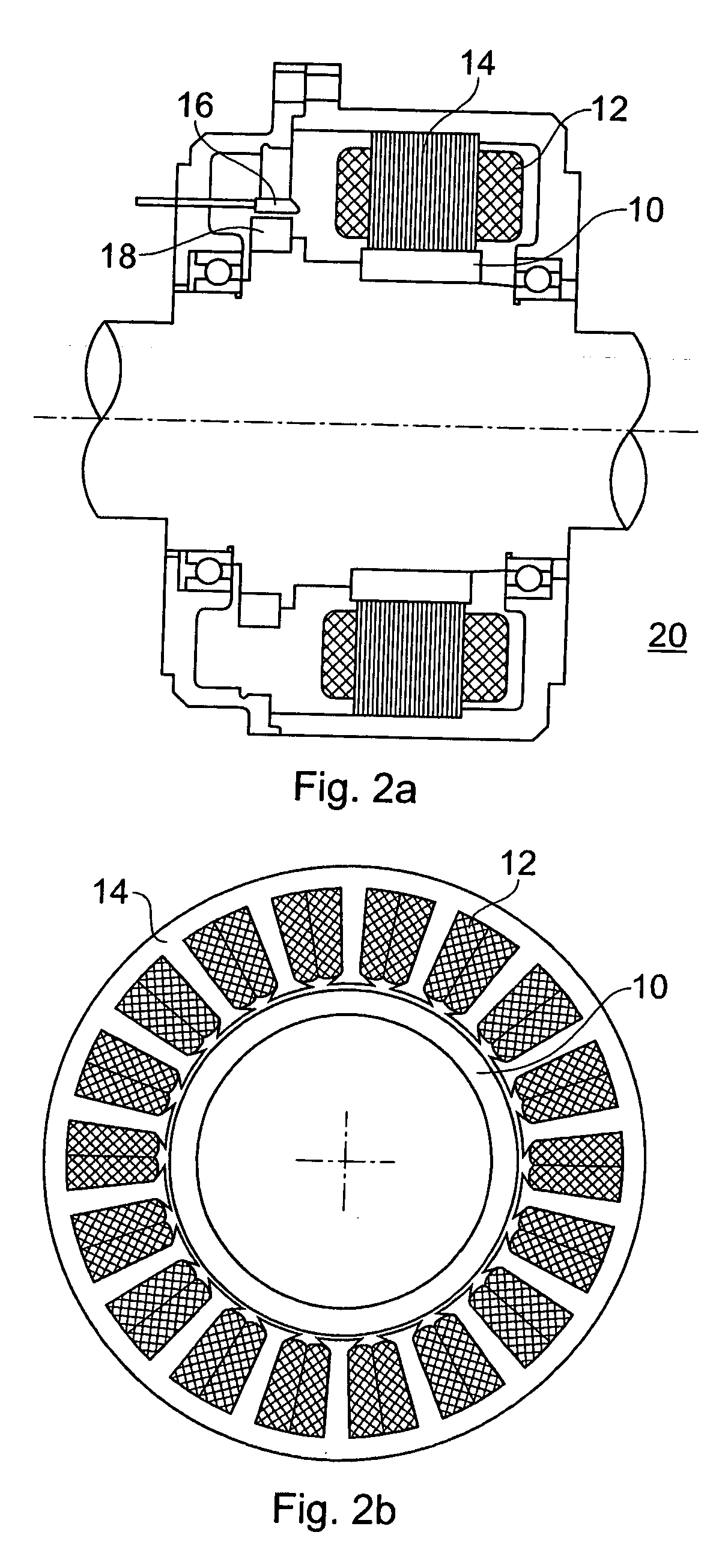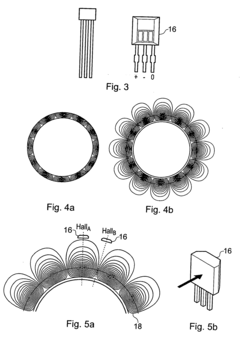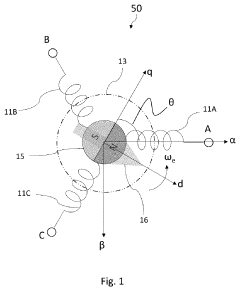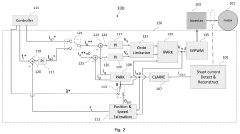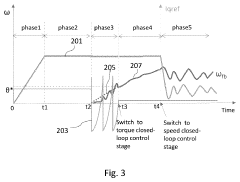Small-scale hydropower generation using PMSM
AUG 15, 20259 MIN READ
Generate Your Research Report Instantly with AI Agent
Patsnap Eureka helps you evaluate technical feasibility & market potential.
PMSM Hydropower Background
Small-scale hydropower generation using Permanent Magnet Synchronous Motors (PMSM) has emerged as a promising solution for sustainable energy production in remote and rural areas. This technology harnesses the power of flowing water in small rivers, streams, or even irrigation canals to generate electricity, offering a clean and renewable alternative to fossil fuels.
The concept of hydropower has been utilized for centuries, with traditional water wheels being the earliest form of mechanical energy extraction from flowing water. However, the integration of PMSM technology in small-scale hydropower systems represents a significant advancement in this field. PMSMs have gained popularity due to their high efficiency, compact size, and excellent power density characteristics.
The evolution of PMSM technology can be traced back to the late 20th century, with significant improvements in permanent magnet materials and power electronics driving its development. The application of PMSMs in hydropower generation began to gain traction in the early 2000s, as researchers and engineers recognized the potential for these motors to operate efficiently as generators in low-head and low-flow conditions.
Small-scale hydropower using PMSM technology offers several advantages over conventional hydroelectric systems. These include reduced environmental impact, lower construction costs, and the ability to generate power in areas with limited water resources. Additionally, the modular nature of PMSM-based systems allows for scalability and easier maintenance, making them suitable for a wide range of applications.
The current trend in small-scale hydropower generation focuses on improving the overall system efficiency, reducing costs, and enhancing the integration with smart grid technologies. Researchers are exploring advanced control strategies, such as maximum power point tracking (MPPT), to optimize power output under varying flow conditions. Furthermore, the development of hybrid systems that combine small-scale hydropower with other renewable energy sources, like solar or wind, is gaining attention as a means to enhance energy reliability and stability.
As global efforts to combat climate change intensify, the demand for clean and sustainable energy solutions continues to grow. Small-scale hydropower generation using PMSM technology aligns well with these goals, offering a viable option for decentralized power production in remote areas and contributing to the diversification of the energy mix. The ongoing research and development in this field aim to address challenges such as environmental concerns, grid integration, and long-term reliability, paving the way for wider adoption of this technology in the coming years.
The concept of hydropower has been utilized for centuries, with traditional water wheels being the earliest form of mechanical energy extraction from flowing water. However, the integration of PMSM technology in small-scale hydropower systems represents a significant advancement in this field. PMSMs have gained popularity due to their high efficiency, compact size, and excellent power density characteristics.
The evolution of PMSM technology can be traced back to the late 20th century, with significant improvements in permanent magnet materials and power electronics driving its development. The application of PMSMs in hydropower generation began to gain traction in the early 2000s, as researchers and engineers recognized the potential for these motors to operate efficiently as generators in low-head and low-flow conditions.
Small-scale hydropower using PMSM technology offers several advantages over conventional hydroelectric systems. These include reduced environmental impact, lower construction costs, and the ability to generate power in areas with limited water resources. Additionally, the modular nature of PMSM-based systems allows for scalability and easier maintenance, making them suitable for a wide range of applications.
The current trend in small-scale hydropower generation focuses on improving the overall system efficiency, reducing costs, and enhancing the integration with smart grid technologies. Researchers are exploring advanced control strategies, such as maximum power point tracking (MPPT), to optimize power output under varying flow conditions. Furthermore, the development of hybrid systems that combine small-scale hydropower with other renewable energy sources, like solar or wind, is gaining attention as a means to enhance energy reliability and stability.
As global efforts to combat climate change intensify, the demand for clean and sustainable energy solutions continues to grow. Small-scale hydropower generation using PMSM technology aligns well with these goals, offering a viable option for decentralized power production in remote areas and contributing to the diversification of the energy mix. The ongoing research and development in this field aim to address challenges such as environmental concerns, grid integration, and long-term reliability, paving the way for wider adoption of this technology in the coming years.
Market for Small-scale Hydropower
The market for small-scale hydropower has been experiencing significant growth in recent years, driven by increasing demand for clean and renewable energy sources. This sector offers a unique opportunity to harness the power of flowing water in smaller streams and rivers, providing localized energy solutions with minimal environmental impact.
Small-scale hydropower systems, typically defined as installations with a capacity of up to 10 MW, have gained traction in both developed and developing countries. In rural and remote areas, these systems offer a reliable and cost-effective alternative to grid extension, contributing to rural electrification efforts and improving the quality of life for local communities.
The global small hydropower market was valued at approximately $2.5 billion in 2020 and is projected to reach $3.5 billion by 2026, growing at a CAGR of around 5.8% during the forecast period. This growth is attributed to several factors, including government initiatives promoting renewable energy, increasing energy demand in developing countries, and the need for decentralized power generation.
Asia-Pacific region dominates the small-scale hydropower market, with China leading in terms of installed capacity. Europe and North America follow, with countries like Italy, France, and the United States showing significant adoption rates. In developing regions such as Africa and Latin America, small hydropower projects are gaining momentum as a means to address energy poverty and promote sustainable development.
The market landscape is characterized by a mix of established players and new entrants, including equipment manufacturers, project developers, and utility companies. Key market players are focusing on technological advancements to improve efficiency and reduce costs, with a particular emphasis on modular and standardized solutions that can be easily deployed in various locations.
Permanent Magnet Synchronous Motors (PMSM) have emerged as a promising technology for small-scale hydropower generation. These motors offer higher efficiency, improved power density, and better control capabilities compared to traditional induction generators. The integration of PMSM in small hydropower systems is expected to drive market growth further by enhancing overall system performance and reliability.
Despite the positive outlook, the small-scale hydropower market faces challenges such as high initial investment costs, environmental concerns, and regulatory hurdles. However, ongoing technological advancements, supportive government policies, and increasing awareness of the benefits of distributed renewable energy systems are expected to overcome these barriers and sustain market growth in the coming years.
Small-scale hydropower systems, typically defined as installations with a capacity of up to 10 MW, have gained traction in both developed and developing countries. In rural and remote areas, these systems offer a reliable and cost-effective alternative to grid extension, contributing to rural electrification efforts and improving the quality of life for local communities.
The global small hydropower market was valued at approximately $2.5 billion in 2020 and is projected to reach $3.5 billion by 2026, growing at a CAGR of around 5.8% during the forecast period. This growth is attributed to several factors, including government initiatives promoting renewable energy, increasing energy demand in developing countries, and the need for decentralized power generation.
Asia-Pacific region dominates the small-scale hydropower market, with China leading in terms of installed capacity. Europe and North America follow, with countries like Italy, France, and the United States showing significant adoption rates. In developing regions such as Africa and Latin America, small hydropower projects are gaining momentum as a means to address energy poverty and promote sustainable development.
The market landscape is characterized by a mix of established players and new entrants, including equipment manufacturers, project developers, and utility companies. Key market players are focusing on technological advancements to improve efficiency and reduce costs, with a particular emphasis on modular and standardized solutions that can be easily deployed in various locations.
Permanent Magnet Synchronous Motors (PMSM) have emerged as a promising technology for small-scale hydropower generation. These motors offer higher efficiency, improved power density, and better control capabilities compared to traditional induction generators. The integration of PMSM in small hydropower systems is expected to drive market growth further by enhancing overall system performance and reliability.
Despite the positive outlook, the small-scale hydropower market faces challenges such as high initial investment costs, environmental concerns, and regulatory hurdles. However, ongoing technological advancements, supportive government policies, and increasing awareness of the benefits of distributed renewable energy systems are expected to overcome these barriers and sustain market growth in the coming years.
PMSM Hydropower Challenges
The implementation of small-scale hydropower generation using Permanent Magnet Synchronous Motors (PMSM) faces several significant challenges. These obstacles span technical, economic, and environmental domains, requiring innovative solutions to ensure the viability and efficiency of such systems.
One of the primary technical challenges is the optimization of PMSM design for variable water flow conditions. Small-scale hydropower installations often experience fluctuations in water flow rates due to seasonal changes or irregular precipitation patterns. This variability necessitates a PMSM that can maintain high efficiency across a wide range of operating conditions, a requirement that pushes the boundaries of current motor design capabilities.
The integration of power electronics and control systems presents another hurdle. Sophisticated power converters and advanced control algorithms are essential for maximizing energy extraction and ensuring grid compatibility. However, developing robust, cost-effective solutions that can withstand harsh environmental conditions while maintaining high reliability remains a significant challenge.
Environmental concerns also pose challenges to small-scale hydropower implementation. The installation of these systems can potentially disrupt local ecosystems, particularly fish populations. Designing fish-friendly turbines and implementing effective fish passage systems are crucial but technically demanding tasks that require interdisciplinary expertise.
From an economic perspective, the high initial investment costs associated with small-scale hydropower projects using PMSM technology can be prohibitive. The specialized nature of the equipment and the need for site-specific designs often result in higher per-kilowatt costs compared to larger hydropower installations or other renewable energy sources. Reducing these costs while maintaining performance is a key challenge for wider adoption.
Maintenance and longevity of PMSM-based hydropower systems in aquatic environments present additional challenges. Ensuring adequate protection against water ingress, corrosion, and sediment erosion is critical for long-term reliability. Developing innovative sealing technologies and materials that can withstand these conditions without compromising performance or increasing costs significantly is an ongoing challenge.
The challenge of grid integration and power quality management is particularly acute for small-scale hydropower systems. Ensuring that the output from these variable renewable sources meets grid standards for frequency, voltage stability, and power factor is essential. This requires advanced control strategies and potentially energy storage solutions, adding complexity and cost to the overall system.
Lastly, the regulatory landscape poses significant challenges. Navigating the complex permitting processes and environmental regulations associated with hydropower projects can be time-consuming and costly. Streamlining these processes while maintaining necessary environmental protections is a challenge that requires collaboration between industry, regulators, and environmental stakeholders.
One of the primary technical challenges is the optimization of PMSM design for variable water flow conditions. Small-scale hydropower installations often experience fluctuations in water flow rates due to seasonal changes or irregular precipitation patterns. This variability necessitates a PMSM that can maintain high efficiency across a wide range of operating conditions, a requirement that pushes the boundaries of current motor design capabilities.
The integration of power electronics and control systems presents another hurdle. Sophisticated power converters and advanced control algorithms are essential for maximizing energy extraction and ensuring grid compatibility. However, developing robust, cost-effective solutions that can withstand harsh environmental conditions while maintaining high reliability remains a significant challenge.
Environmental concerns also pose challenges to small-scale hydropower implementation. The installation of these systems can potentially disrupt local ecosystems, particularly fish populations. Designing fish-friendly turbines and implementing effective fish passage systems are crucial but technically demanding tasks that require interdisciplinary expertise.
From an economic perspective, the high initial investment costs associated with small-scale hydropower projects using PMSM technology can be prohibitive. The specialized nature of the equipment and the need for site-specific designs often result in higher per-kilowatt costs compared to larger hydropower installations or other renewable energy sources. Reducing these costs while maintaining performance is a key challenge for wider adoption.
Maintenance and longevity of PMSM-based hydropower systems in aquatic environments present additional challenges. Ensuring adequate protection against water ingress, corrosion, and sediment erosion is critical for long-term reliability. Developing innovative sealing technologies and materials that can withstand these conditions without compromising performance or increasing costs significantly is an ongoing challenge.
The challenge of grid integration and power quality management is particularly acute for small-scale hydropower systems. Ensuring that the output from these variable renewable sources meets grid standards for frequency, voltage stability, and power factor is essential. This requires advanced control strategies and potentially energy storage solutions, adding complexity and cost to the overall system.
Lastly, the regulatory landscape poses significant challenges. Navigating the complex permitting processes and environmental regulations associated with hydropower projects can be time-consuming and costly. Streamlining these processes while maintaining necessary environmental protections is a challenge that requires collaboration between industry, regulators, and environmental stakeholders.
Current PMSM Hydropower Solutions
01 Motor design and structure
Innovations in PMSM design focus on improving efficiency and performance. This includes optimizing rotor and stator configurations, magnet arrangements, and overall motor structure to enhance power density, reduce losses, and improve thermal management.- Motor design and structure: Permanent Magnet Synchronous Motors (PMSMs) have specific design features and structural elements that enhance their performance. These may include optimized rotor and stator configurations, improved magnet arrangements, and innovative cooling systems. Such design improvements can lead to increased efficiency, power density, and overall motor performance.
- Control strategies for PMSMs: Advanced control techniques are crucial for optimizing PMSM operation. These may include sensorless control methods, adaptive control algorithms, and advanced vector control strategies. Such control approaches can improve motor efficiency, dynamic response, and stability across various operating conditions.
- Efficiency improvement techniques: Various methods are employed to enhance the efficiency of PMSMs. These can include the use of advanced materials for magnets and core components, optimization of winding designs, and implementation of energy recovery systems. Such improvements can lead to reduced losses and increased overall system efficiency.
- Fault diagnosis and condition monitoring: Developing robust fault diagnosis and condition monitoring systems for PMSMs is crucial for ensuring reliable operation. These systems may utilize advanced sensors, data analytics, and machine learning algorithms to detect and predict potential faults, enabling preventive maintenance and reducing downtime.
- Integration with power electronics and drive systems: Effective integration of PMSMs with power electronics and drive systems is essential for optimal performance. This includes the development of specialized inverters, power converters, and control units tailored for PMSM applications. Such integration can lead to improved system efficiency, reduced harmonics, and enhanced overall drive performance.
02 Control strategies and algorithms
Advanced control techniques are developed for PMSMs to improve their operation. These include sensorless control methods, adaptive control algorithms, and optimization techniques for various operating conditions, enhancing efficiency and dynamic performance.Expand Specific Solutions03 Fault detection and diagnosis
Methods and systems for detecting and diagnosing faults in PMSMs are developed to improve reliability and maintenance. These include techniques for identifying issues such as demagnetization, winding faults, and bearing failures, often using advanced signal processing and machine learning algorithms.Expand Specific Solutions04 Integration with power electronics
Advancements in integrating PMSMs with power electronic systems are made to optimize overall system performance. This includes improvements in inverter design, modulation techniques, and power management strategies to enhance efficiency and reduce electromagnetic interference.Expand Specific Solutions05 Application-specific optimizations
PMSMs are optimized for specific applications such as electric vehicles, industrial drives, and renewable energy systems. These optimizations involve tailoring motor characteristics, control strategies, and system integration to meet the unique requirements of each application, improving overall system performance and efficiency.Expand Specific Solutions
Key PMSM Hydropower Players
The small-scale hydropower generation using PMSM market is in a growth phase, driven by increasing demand for renewable energy solutions. The global market size is expanding, with projections indicating significant growth potential in the coming years. Technologically, the field is advancing rapidly, with companies like NuScale Power LLC and Yaskawa Electric Corp. leading innovation in power systems and motor technologies. Research institutions such as the Korea Institute of Energy Research and North China Electric Power University are contributing to technological advancements. While the technology is maturing, there's still room for improvement in efficiency and cost-effectiveness, presenting opportunities for companies like Nidec Instruments Corp and Wison Engineering Ltd. to develop specialized solutions for small-scale hydropower applications.
Nidec Instruments Corp
Technical Solution: Nidec Instruments Corp has developed a comprehensive small-scale hydropower solution utilizing PMSM technology. Their system integrates a high-performance permanent magnet synchronous generator with advanced power electronics and intelligent control algorithms. Nidec's approach focuses on maximizing energy conversion efficiency across a wide range of water flow rates, employing variable speed operation to optimize power output[1]. The company's PMSM design incorporates rare-earth magnets and optimized stator windings to achieve high power density and excellent thermal management[2]. Nidec's solution also features a modular design, allowing for easier installation and maintenance in remote or challenging locations typical of small hydropower sites[3].
Strengths: High efficiency, wide operating range, modular design for easy installation and maintenance. Weaknesses: Dependency on rare-earth materials, potentially higher upfront costs compared to conventional systems.
North China Electric Power University
Technical Solution: North China Electric Power University has developed an innovative approach to small-scale hydropower generation using PMSM technology. Their research focuses on optimizing the design and control of permanent magnet synchronous generators for variable speed operation in micro-hydro applications. The university's solution incorporates advanced magnetic circuit designs to maximize flux density and reduce cogging torque, resulting in improved generator efficiency and smoother operation[1]. They have also developed novel control algorithms that adapt to changing water flow conditions, ensuring optimal power extraction across a wide range of operational scenarios[2]. The university's research includes the integration of power electronic converters specifically tailored for small-scale hydropower, addressing issues such as grid synchronization and power quality[3].
Strengths: Cutting-edge research in PMSM design and control, focus on efficiency and adaptability to variable conditions. Weaknesses: Potential gap between academic research and commercial implementation, may require further development for large-scale deployment.
PMSM Hydropower Innovations
Permanent magnet synchronous motor and controller therefor
PatentInactiveUS20050248306A1
Innovation
- A low-cost open-loop sinusoidal control system using two linear Hall sensors spaced 90 electrical degrees apart to detect the rotor magnetic field, with a two-phase-type phase-lock-loop (TP-PLL) for normalizing the sensor signals, transforming them into 3-phase synchronous sinusoidal waveforms for PWM control, eliminating the need for current measurement and high-performance MCUs.
Permanent magnet synchronous motor (PMSM) and method for starting the PMSM
PatentActiveUS11942882B2
Innovation
- A multi-stage control method involving opening a control loop, aligning the rotor with a first direction, abruptly setting a second direction perpendicular to the first, and transitioning through asynchronous driving and closed-loop modes to ensure smooth startup and synchronization.
Environmental Impact Assessment
The environmental impact assessment of small-scale hydropower generation using Permanent Magnet Synchronous Motors (PMSM) reveals both positive and negative effects on the surrounding ecosystem. This analysis is crucial for understanding the overall sustainability of such projects and their long-term viability.
One of the primary environmental benefits of small-scale hydropower using PMSM is the reduction in greenhouse gas emissions compared to fossil fuel-based energy generation. These systems produce clean, renewable energy with minimal carbon footprint during operation. Additionally, the use of PMSM technology enhances energy efficiency, further reducing the overall environmental impact.
However, the construction and installation of small-scale hydropower facilities can lead to localized ecosystem disruption. This may include alterations to river flow patterns, which can affect aquatic habitats and migration routes for fish species. The extent of this impact varies depending on the specific site characteristics and the scale of the project.
The use of PMSM in small-scale hydropower also raises concerns about the sourcing of rare earth materials required for permanent magnets. The mining and processing of these materials can have significant environmental consequences, including soil erosion, water pollution, and habitat destruction in the areas where they are extracted.
Noise pollution is another factor to consider, although the impact is generally minimal compared to larger hydropower installations. The low-noise operation of PMSM contributes to reduced disturbance of local wildlife and nearby human communities.
Water quality can be affected by small-scale hydropower projects, particularly during the construction phase. Sediment disturbance and potential changes in water temperature can impact aquatic ecosystems. However, proper design and management can mitigate these effects, and in some cases, the presence of a well-managed hydropower facility can even improve local water quality through increased oxygenation and sediment control.
The visual impact of small-scale hydropower installations is typically less significant than that of large dams, but it still requires consideration. Careful site selection and design can help minimize the aesthetic impact on the landscape and preserve the natural beauty of the area.
In terms of land use, small-scale hydropower projects using PMSM generally have a smaller footprint compared to other renewable energy sources like solar or wind farms. This can be advantageous in areas where land availability is limited or where preservation of natural habitats is a priority.
Overall, while small-scale hydropower generation using PMSM technology offers significant environmental benefits in terms of clean energy production, a comprehensive assessment must balance these advantages against potential localized impacts on ecosystems and resource extraction concerns. Proper planning, design, and ongoing management are essential to maximize the positive environmental outcomes of these projects.
One of the primary environmental benefits of small-scale hydropower using PMSM is the reduction in greenhouse gas emissions compared to fossil fuel-based energy generation. These systems produce clean, renewable energy with minimal carbon footprint during operation. Additionally, the use of PMSM technology enhances energy efficiency, further reducing the overall environmental impact.
However, the construction and installation of small-scale hydropower facilities can lead to localized ecosystem disruption. This may include alterations to river flow patterns, which can affect aquatic habitats and migration routes for fish species. The extent of this impact varies depending on the specific site characteristics and the scale of the project.
The use of PMSM in small-scale hydropower also raises concerns about the sourcing of rare earth materials required for permanent magnets. The mining and processing of these materials can have significant environmental consequences, including soil erosion, water pollution, and habitat destruction in the areas where they are extracted.
Noise pollution is another factor to consider, although the impact is generally minimal compared to larger hydropower installations. The low-noise operation of PMSM contributes to reduced disturbance of local wildlife and nearby human communities.
Water quality can be affected by small-scale hydropower projects, particularly during the construction phase. Sediment disturbance and potential changes in water temperature can impact aquatic ecosystems. However, proper design and management can mitigate these effects, and in some cases, the presence of a well-managed hydropower facility can even improve local water quality through increased oxygenation and sediment control.
The visual impact of small-scale hydropower installations is typically less significant than that of large dams, but it still requires consideration. Careful site selection and design can help minimize the aesthetic impact on the landscape and preserve the natural beauty of the area.
In terms of land use, small-scale hydropower projects using PMSM generally have a smaller footprint compared to other renewable energy sources like solar or wind farms. This can be advantageous in areas where land availability is limited or where preservation of natural habitats is a priority.
Overall, while small-scale hydropower generation using PMSM technology offers significant environmental benefits in terms of clean energy production, a comprehensive assessment must balance these advantages against potential localized impacts on ecosystems and resource extraction concerns. Proper planning, design, and ongoing management are essential to maximize the positive environmental outcomes of these projects.
Regulatory Framework for Hydropower
The regulatory framework for small-scale hydropower generation using Permanent Magnet Synchronous Motors (PMSM) is a complex and evolving landscape. At the international level, organizations such as the International Hydropower Association (IHA) and the International Energy Agency (IEA) provide guidelines and best practices for sustainable hydropower development, which often influence national policies.
In many countries, small-scale hydropower projects are subject to less stringent regulations compared to large-scale installations. This is due to their reduced environmental impact and potential for distributed energy generation. However, the specific regulatory requirements vary significantly between jurisdictions.
Environmental regulations play a crucial role in the development of small-scale hydropower projects. These typically include requirements for environmental impact assessments, water quality monitoring, and measures to protect aquatic ecosystems and fish populations. The use of PMSMs in these projects may be viewed favorably by regulators due to their higher efficiency and reduced environmental footprint.
Licensing and permitting processes for small-scale hydropower projects often involve multiple agencies, including water resource management authorities, environmental protection agencies, and energy regulators. The complexity of these processes can be a significant barrier to project development, particularly for smaller operators.
Grid connection regulations are another critical aspect of the regulatory framework. Many countries have implemented feed-in tariffs or other incentive schemes to encourage the development of small-scale hydropower. These schemes often include specific provisions for technologies like PMSMs that can enhance system efficiency and grid stability.
Safety regulations for small-scale hydropower installations using PMSMs typically focus on electrical safety, structural integrity, and operational procedures. These may include requirements for regular inspections, maintenance protocols, and emergency shutdown systems.
As the technology for small-scale hydropower generation evolves, regulatory frameworks are adapting to keep pace. There is a growing trend towards streamlining approval processes for small-scale projects while maintaining robust environmental and safety standards. Some jurisdictions are also exploring performance-based regulations that focus on outcomes rather than prescriptive requirements, potentially allowing for greater innovation in technologies like PMSM-based systems.
In many countries, small-scale hydropower projects are subject to less stringent regulations compared to large-scale installations. This is due to their reduced environmental impact and potential for distributed energy generation. However, the specific regulatory requirements vary significantly between jurisdictions.
Environmental regulations play a crucial role in the development of small-scale hydropower projects. These typically include requirements for environmental impact assessments, water quality monitoring, and measures to protect aquatic ecosystems and fish populations. The use of PMSMs in these projects may be viewed favorably by regulators due to their higher efficiency and reduced environmental footprint.
Licensing and permitting processes for small-scale hydropower projects often involve multiple agencies, including water resource management authorities, environmental protection agencies, and energy regulators. The complexity of these processes can be a significant barrier to project development, particularly for smaller operators.
Grid connection regulations are another critical aspect of the regulatory framework. Many countries have implemented feed-in tariffs or other incentive schemes to encourage the development of small-scale hydropower. These schemes often include specific provisions for technologies like PMSMs that can enhance system efficiency and grid stability.
Safety regulations for small-scale hydropower installations using PMSMs typically focus on electrical safety, structural integrity, and operational procedures. These may include requirements for regular inspections, maintenance protocols, and emergency shutdown systems.
As the technology for small-scale hydropower generation evolves, regulatory frameworks are adapting to keep pace. There is a growing trend towards streamlining approval processes for small-scale projects while maintaining robust environmental and safety standards. Some jurisdictions are also exploring performance-based regulations that focus on outcomes rather than prescriptive requirements, potentially allowing for greater innovation in technologies like PMSM-based systems.
Unlock deeper insights with Patsnap Eureka Quick Research — get a full tech report to explore trends and direct your research. Try now!
Generate Your Research Report Instantly with AI Agent
Supercharge your innovation with Patsnap Eureka AI Agent Platform!

